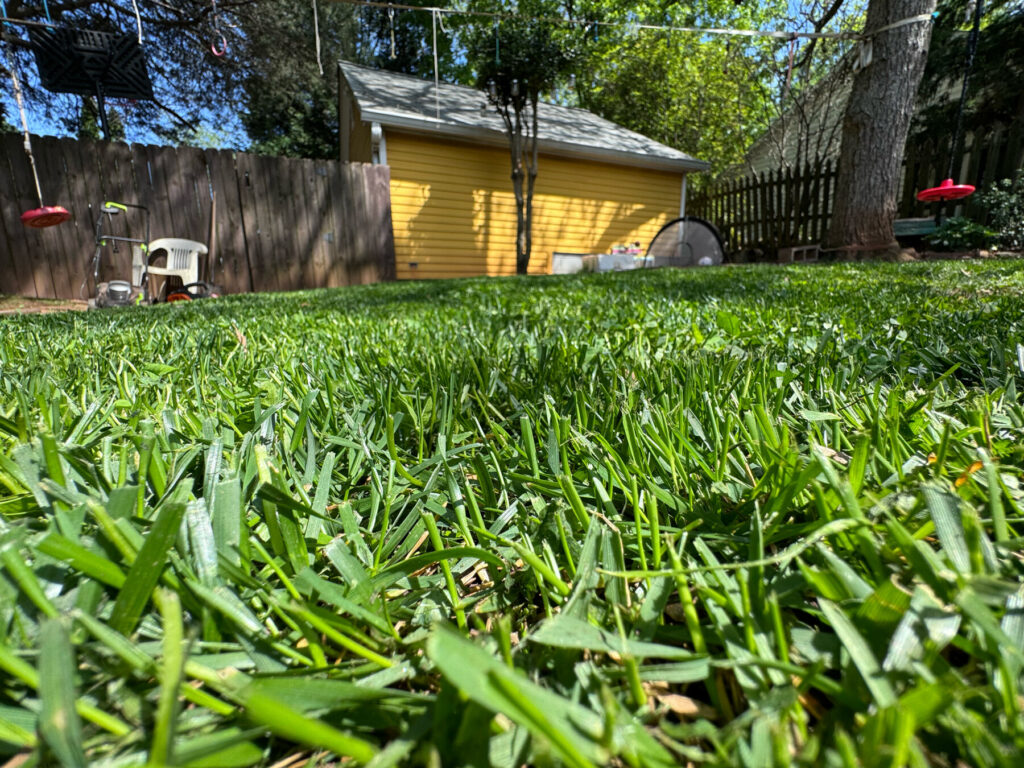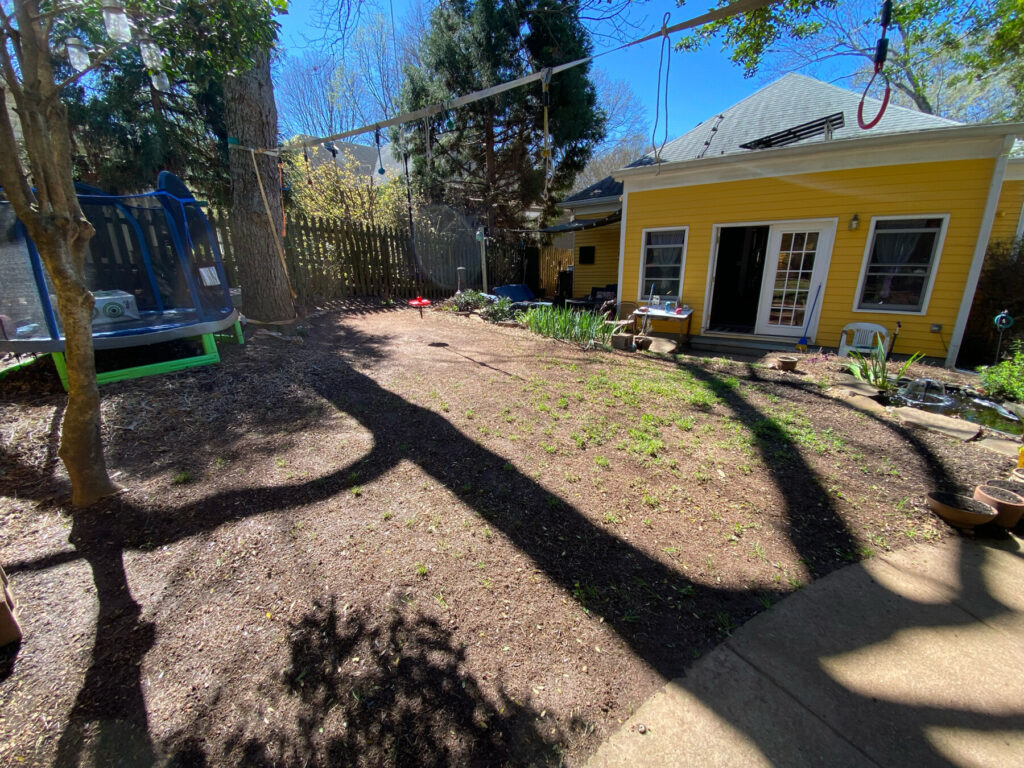by Jason Parker, Fulton County Master Gardener Extension Volunteer

“As long as it’s all green and the same height” is the only lawn advice I’d ever really followed, until my lawn suddenly went extinct. Well, “suddenly” in the sense that I didn’t do anything about it until the grass was all gone.
Our very small lawn in Grant Park was always thick, green, and lovely. In summers I had to mow it twice a week. At the time I hadn’t taken any interest in grass, but I was pretty sure it was bermudagrass.
Then in about 2018 we had weeks of no rain at all in Atlanta. I could see the soil shriveling up as it dried out. I recall thinking, “I ought to water.” I didn’t. Coincidentally, this all started about three years after our second child was born, which could have played some role in my garden priorities.
Then, suddenly it was weeks of downpour, and my grass was gone.
Over the course of COVID, everyone at home all the time and then getting a dog, our backyard became a solid clay surface littered with little rocks. Eventually I wanted to walk on grass at home again and began my amateur lawn rehabilitation efforts–a long, difficult quest carried out with not much but a shovel and cussedness.


Here are some of the things I’ve done, and what I’ve learned in the process of bringing my tiny but much-loved lawn back from the dead.
Get a Soil Test
I did the little shaker tests from the hardware store, sent away to a subscription service for one (“ideal soil” they said, conveniently recommending their own products), and followed the recommendations as well as I could figure from reading packages and the Internet. Lime? pH? Bone meal? Blood meal? A lot of my troubles would have been resolved with a soil test from the Extension office.
Add Compost (and Worms!)
The lawn never had lasting success until I started dropping shovelfuls of our home compost on it. I began digging out worms and rehoming them in the yard. Somewhere along the way, I’d read that you should be able to easily count ten worms in a cubic foot of soil. The yard was too hard to dig more than a few inches, so I had to start from scratch (literally!). A couple years of adding living soil and worms to the lawn have helped it survive and expand.
Look for the Sun
We lost the lawn after living in our home for twelve years. Following rounds of soon-dead, “deep shade” mixes, I eventually had the sense to look up. Sure enough, trees grow over time! Our neighbor’s cedars, tea olives, and our pecan tree had swallowed up our whole southern exposure.
My neighbor was delighted when I asked to prune the top ten feet of her tea olives. Gardeners make good neighbors! Cutting the trees created a nice sky hole along our fence and added hours of sunlight to my lawn. Nature helped too when our other side neighbors’ tree fell and created another big sunlight window.
Look for the Water
Hard rains really beat up the ground, and most if it ran downhill like it runs down pavement. I put in one of those rubber edging things to save some dirt. Leftover yard bricks (so many!), pecan shell berms, flower pots, and limbs created erosion-disrupting curbs. I have to keep at it, watching for runoff while it rains and looking for spilled soil afterward. Those I’ll need to address before the next storm.

Try Clover
Finally, after the bermudagrass and shade mixes kept dying, I came across white clover on the internet. I read that clover could add nitrogen, survive in clay and shade, was hardy, attracts pollinators, and reseeds itself. Perfect! All I really want from a lawn is a little area I can walk barefoot or lay in. So I mixed up a couple pounds of white clover ordered online with some fescue and rye mix from the store.
During Master Gardener training, we learned about cool- and warm-season grasses. I inspected my bag of rye seeds and noticed they come from Oregon and Washington (read labels!). Somewhere along the information superhighway I found an article about how clover had been the lawn cover of choice in the U.S. until the 1950s, when grass became popular and clover became a weed.
My yard is on its way now to all green and the same height. The clover mixed in with other seed like rye and bermuda is expanding. I often amend with compost and garden soil, aerate, add worms, and water regularly.
There are still bare patches to fill, and the kid area is a lost cause until they’ve moved on. But this is my year! Grass, like everything that grows, needs attention. Over the last few years I’ve learned a little about how to give it, and that there’s help available when I need it.
Learn More
- Lawns in Georgia: Selection and Species
- UGA Extension Soil and Water Testing Services
- Ground Covers for Shaded Landscapes in North Georgia
- White Clover Species and Varieties
- National Gallery of Art’s History of Early American Landscape Design: Lawn
- 9 Reasons Why a Clover Lawn is Better Than a Grass Lawn
About the Author

Jason Parker is a creative media producer and Master Gardener intern volunteer in Fulton County. Jason spent his coastal Georgia childhood mowing grass and digging in the dirt. Now, muuuch later in life, he enjoys sharing new and old lessons to improve his own and others’ gardening skills.